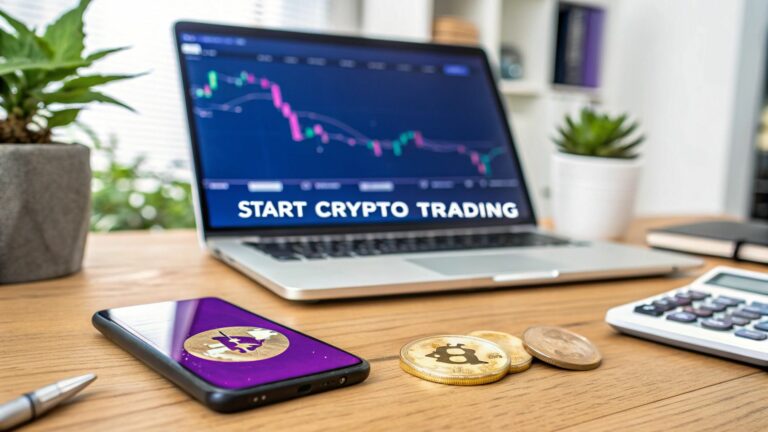Getting started with crypto trading isn't as intimidating as it looks. The whole process, from picking an exchange to placing your first trade, can honestly be done in just a few hours if you're on a straightforward platform like vTrader.
Your First Steps Into Crypto Trading
Diving into crypto can feel like a massive leap. Let's be real, there's a ton of noise out there. This guide is designed to cut right through it, giving you a practical, no-fluff starting point based on what actually works. I'll walk you through exactly where to begin so you can get started with confidence.
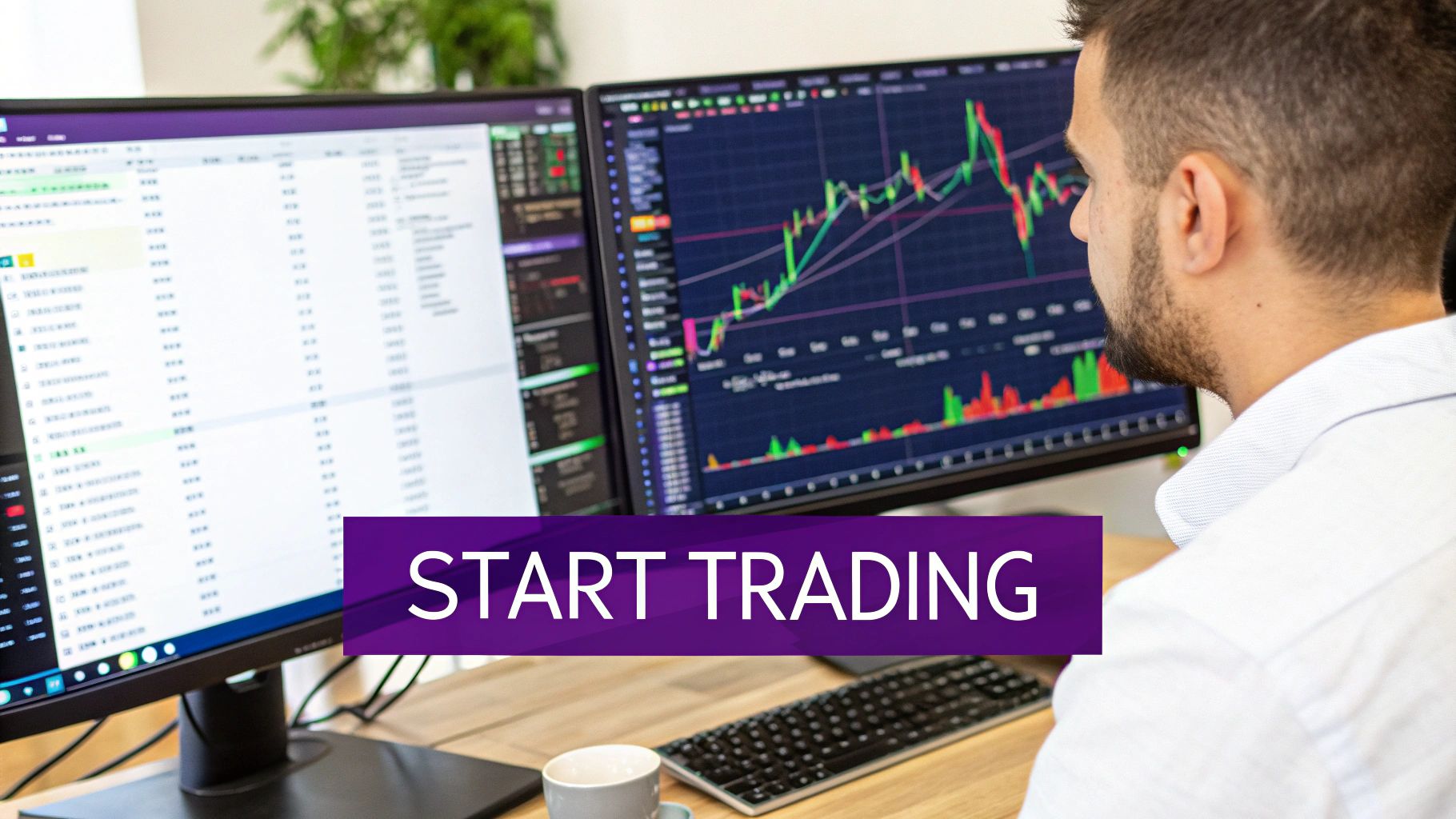
Picking Your Platform
Your first, and arguably most important, decision is choosing where you'll trade. This isn't just a minor detail—it impacts your security, the fees you'll pay, and which coins you can even buy. For this walkthrough, we'll focus on vTrader. It's a solid choice for newcomers because of its commission-free model, tight security, and an interface that doesn't feel like rocket science.
The crypto space is exploding. Projections show the global market could blast past $2.87 billion in 2025 and potentially hit $5.43 billion by 2029. With that kind of growth, you want an exchange that’s built to last.
Laying a Solid Foundation
Before you even think about buying your first Bitcoin or Ethereum, you need to get your financial house in order. Seriously. Having a grasp of basic financial planning principles is what separates successful traders from those who get wiped out. It helps you manage risk and set goals you can actually achieve in these volatile markets.
A classic rookie mistake is jumping into trades without any real plan, just chasing quick profits. Don't do it. Your first few trades should be about learning the ropes safely, not trying to get rich overnight. Think of it as paying for your education.
With that foundation in place, the next steps are pretty simple:
- Choose a Trusted Exchange: Look for strong security, clear fees, and a good reputation. vTrader, for example, is registered with FinCEN and offers zero-fee trading, which is a huge plus.
- Verify Your Identity: This is the Know Your Customer (KYC) process. You'll need to provide some ID. It's a standard regulatory step that protects both you and the platform.
- Fund Your Account: Link a bank account or use a debit card to deposit your starting capital. And please, only start with an amount you're genuinely okay with losing while you learn.
- Know Your Orders: Get familiar with the difference between a market order and a limit order. This is fundamental knowledge you need before you click "buy."
To give you a clear roadmap, here's a quick checklist to follow.
Quick-Start Checklist for New Crypto Traders
This table breaks down the essential first steps for anyone starting their crypto journey on vTrader. Think of it as your launch sequence.
| Action Item | Why It's Important | Key Takeaway |
|---|---|---|
| Choose a Secure Exchange | Your funds' safety and your trading experience depend on it. | Opt for regulated platforms like vTrader with strong security features. |
| Complete KYC Verification | This is a mandatory regulatory step that legitimizes your account. | Have your ID ready; it’s a one-time process for your protection. |
| Fund Your Account | You need capital to trade, but you must start responsibly. | Start small. Use an amount you can afford to lose as "tuition." |
| Learn Basic Order Types | Knowing how to buy/sell effectively prevents costly mistakes. | Master market vs. limit orders before placing any trade. |
| Place Your First Trade | This is where theory meets practice. It makes the process real. | Your goal is to learn the platform, not to hit a home run. |
Following these actions will set you on the right path and help you avoid the common pitfalls that trip up new traders.
If you're eager to get a deeper understanding of the fundamentals, the vTrader learning center is a goldmine. You can find detailed guides and tutorials in our academy to really build out your knowledge. Our goal here is to swap that initial confusion for real, actionable confidence. Starting in crypto is absolutely within your reach.
Creating and Securing Your vTrader Account
Think of your crypto exchange account as your personal digital vault. How you construct and fortify its walls from the very beginning is one of the most critical steps you'll take as a trader. This goes way beyond just picking a password; it's about setting up robust defenses to protect your funds for the long haul.
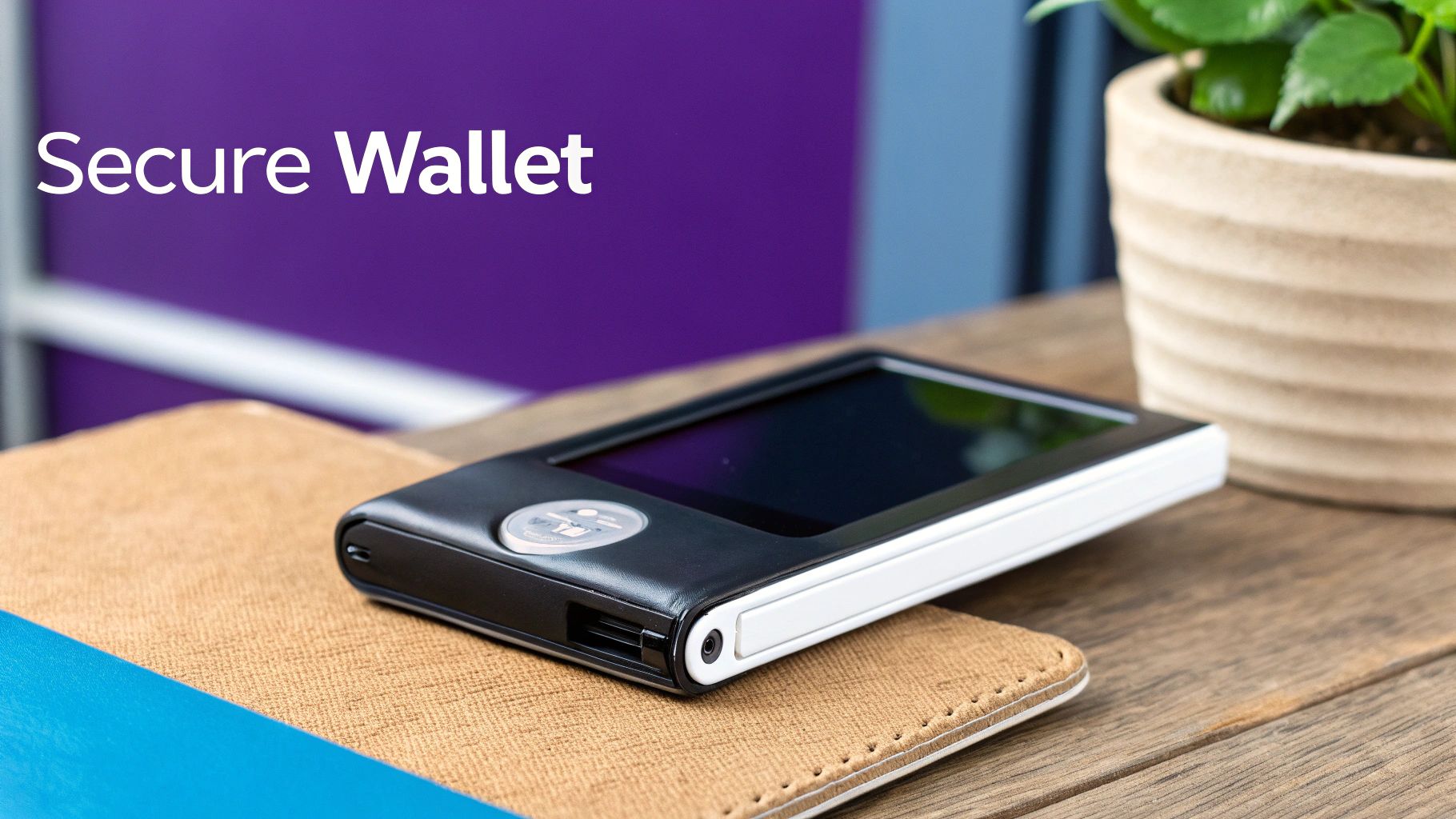
Getting started on vTrader is pretty intuitive. You'll kick things off with the basics: your email and a strong, unique password. I can't stress this enough—don't recycle a password you've used anywhere else. Create something long and complex with a mix of letters, numbers, and symbols. Even better, let a password manager generate one for you. This is your first line of defense.
Activating Two-Factor Authentication (2FA)
Once your password is set, the next move isn't just a recommendation; it's absolutely essential for anyone serious about security. You need to enable Two-Factor Authentication (2FA). This adds a crucial second layer of protection, demanding a time-sensitive code from another device—usually your phone—before you can log in or make a withdrawal.
You generally get two choices for 2FA:
- SMS-based: You’ll get a code via text message. While it's better than nothing, this method is vulnerable to "SIM-swapping," an attack where a scammer convinces your mobile provider to transfer your number to their own device.
- Authenticator App: This involves using an app like Google Authenticator or Authy. From my experience, this is by far the more secure option. The codes are generated offline on your device, making them completely immune to SIM-swapping schemes.
Setting it up is a breeze. Just download an authenticator app, scan the QR code vTrader provides, and enter the six-digit code to sync your account. From that point on, you'll need both your password and a fresh code from the app to get in.
Understanding the KYC Process
After setting up your basic account, you'll be guided through the Know Your Customer (KYC) process. This is a standard, one-time identity check required by regulated exchanges like vTrader. It might seem like a bit of a hassle at first, but it’s a critical measure that ultimately protects everyone on the platform.
KYC is what helps prevent illicit activities and ensures the exchange is operating within financial regulations. For you, it’s a sign that the exchange is legitimate and playing by the rules. You'll typically need to provide just two things:
- A photo of a government-issued ID (like a driver's license or passport).
- A quick selfie to prove you're the person on the ID.
The whole thing is usually automated and only takes a few minutes. vTrader walks you through it step by step. It’s simply a fundamental part of trading crypto responsibly these days.
Key Takeaway: Think of KYC as a stamp of legitimacy. Exchanges that enforce it are showing a real commitment to security and regulatory compliance—exactly what you want when your money is on the line. It helps weed out bad actors and creates a safer trading environment for everyone.
Finalizing your account setup also means you're agreeing to the platform's rules of engagement. It’s always smart to have a look at the legal framework governing your trading. You can find all the details by reviewing the vTrader terms and conditions.
With your identity verified and 2FA locked in, your vTrader account is now both created and properly secured. You've built a solid foundation—not just for trading, but for protecting your digital assets well into the future. Your secure launchpad is officially ready for the next stage: funding your account.
Funding Your Account and Reading The Market
Alright, your account is set up and secure. Now for the exciting part: getting some capital in there so you can start making moves. This is the moment you go from just watching the markets to actually participating in them. We'll walk through the best ways to fund your vTrader account and then get into the core metrics you need to know to read what the market is telling you.
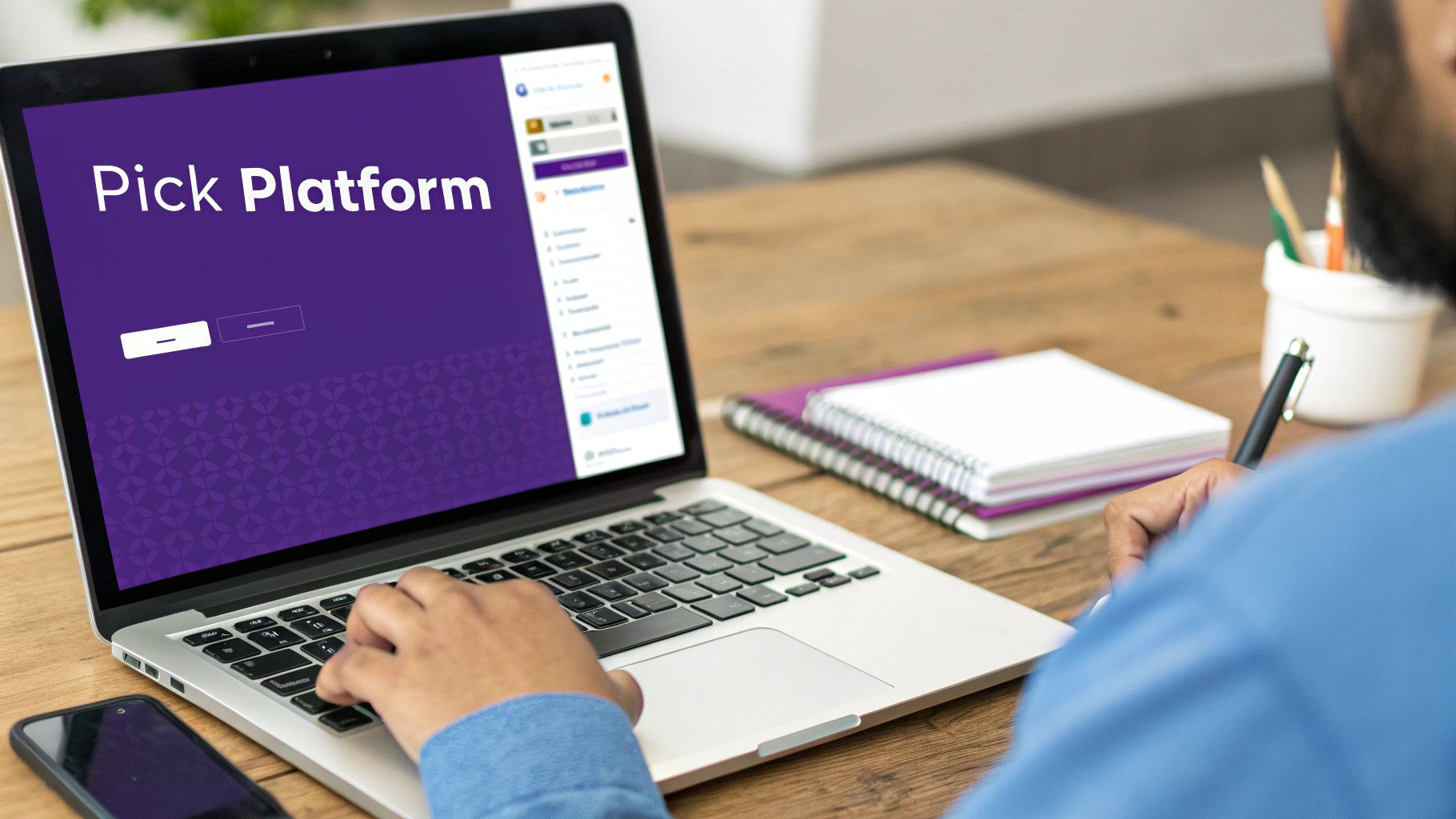
Choosing Your Funding Method
Getting money into your vTrader account is pretty simple, but you'll have to choose between speed and cost. There’s no single "best" way; it really just depends on how quickly you need the funds.
Here's the breakdown of your main options:
- Bank Transfers (ACH): This is my go-to for bigger deposits. Why? Because the fees are usually much lower, or even zero. The only catch is that it’s not instant. You’ll have to wait a few business days for the funds to clear before you can trade with them.
- Debit Cards: If you spot an opportunity and need to act now, a debit card is your friend. The deposit is almost immediate, letting you jump on a trade right away. That convenience comes with a small price, usually a percentage-based fee on the deposit amount.
Before you pull the trigger, it’s always a good idea to check the exact costs. You can find a full breakdown of deposit and withdrawal fees on the official vTrader fee schedule. A quick look can save you from any unexpected charges.
Understanding Core Market Indicators
Once you're funded, the real learning begins. You don't need to be a data scientist to understand the market, but you do need to get a feel for a few key indicators that paint a picture of a crypto's health.
Market Capitalization (Market Cap) is a big one. It’s simply the total value of all of a crypto's coins currently in existence. You get this number by multiplying the coin's current price by its circulating supply. Think of it as a rough measure of a project’s size and stability. Projects with a massive market cap, like Bitcoin or Ethereum, are generally seen as less risky than some new coin with a tiny market cap.
Next up is Trading Volume. This tells you how much of a specific crypto was bought and sold over a set period, usually 24 hours. High volume is a good sign—it means there's a lot of interest and it's easy to get in and out of a position without causing a massive price swing.
Key Insight: High trading volume and high liquidity are two sides of the same coin. When an asset is being heavily traded, it’s a healthy sign. You can buy or sell smoothly. Trying to offload a low-volume asset at a good price can be a real headache.
Getting a handle on these concepts is your entry ticket into a massive and growing financial arena. The global crypto market hit a valuation of around $2.1 billion in 2024 and is on track to reach $5 billion by 2030. A lot of that growth is fueled by the explosion in decentralized finance (DeFi), which offers an alternative to the old-school banking system.
Bitcoin vs Altcoins: A Practical Starting Point
In the crypto space, you'll constantly hear two terms: Bitcoin and altcoins. Bitcoin (BTC) is the OG, the first and still the largest crypto by a long shot. Altcoins is just a catch-all term for everything else, from giants like Ethereum (ETH) down to thousands of smaller, highly speculative projects.
If you ask any seasoned trader for advice, they’ll almost always tell you the same thing: start with Bitcoin. There are a few good reasons for this:
- Established Track Record: It’s been around the longest and has survived multiple market meltdowns.
- High Liquidity: It’s the most-traded crypto, so you’ll never have trouble finding a buyer or seller.
- Lower Relative Volatility: It's still a wild ride, but Bitcoin's price swings are often less chaotic than those of smaller altcoins.
The siren song of massive gains from a hot new altcoin can be hard to ignore, but they come with sky-high risk. A much smarter play is to get your feet wet with Bitcoin first. Once you’re comfortable with the market’s rhythm, you can start cautiously branching out. This approach helps you build a solid foundation for making calculated moves, not just blind bets.
How To Make Your First Crypto Trade
This is where the rubber meets the road. You’ve got a funded and secured vTrader account, and now it’s time to jump in and place your very first trade. We’ll walk through the entire process, step by practical step, so you can ditch the guesswork and trade with confidence.
Getting to Know the vTrader Dashboard
When you first land on the vTrader dashboard, it can feel a little overwhelming. Charts, numbers, and buttons are everywhere. Don't worry. The trick is knowing what to focus on and what you can ignore for now. Your main points of interest are the asset pair selector, the order entry box, and your trade history tab.
For this first trade, we're keeping it simple by buying a small amount of Bitcoin. In the asset selector, you'll want to find the BTC/USD pair. This simply means you're trading US Dollars for Bitcoin—think of it like swapping currencies at an airport, but for digital assets.
Market Orders vs. Limit Orders: What’s the Difference?
Before you hit that "buy" button, you need to understand the two main ways to place an order. This is one of the most fundamental concepts in trading. Getting it right from the get-go will save you a lot of headaches later on.
-
Market Order: This is the most straightforward option. It tells the exchange, "Buy Bitcoin for me right now at the best available price." It’s fast and pretty much guarantees your order gets filled, but you don’t have precise control over the exact price you pay. For a beginner who just wants to get some skin in the game, this is usually the best choice.
-
Limit Order: This gives you more control. A limit order says, "Buy Bitcoin for me, but only if the price drops to my target or lower." For instance, if Bitcoin is trading at $70,500, you could set a limit order to buy at $70,000. Your order will only go through if the price hits that level. It's great for getting the price you want, but there’s no guarantee your order will ever fill if the market never dips to your target.
For this first go-around, a market order is perfect. The goal is just to learn the mechanics of the platform, not to nail the perfect market entry.
A Practical Walkthrough: Buying Your First Bitcoin
Let’s put this all into practice. Imagine you've decided to start your crypto journey by buying $50 worth of Bitcoin.
First, head to the order entry box on the vTrader dashboard and make sure the BTC/USD pair is selected. Next, choose the "Market" order type. In the field labeled "Amount," just type in "$50."
vTrader will then pop up a summary of your order. This preview is your chance to double-check everything. It will show you the approximate amount of Bitcoin you’ll get and, most importantly, any fees. Since vTrader offers commission-free trading, you'll see a big fat zero for the platform fee—a massive plus for new traders. Once you're happy with the details, click "Confirm Buy."
And that’s it. The platform will execute the trade almost instantly.
Pro Tip: Don't get hung up on buying a whole Bitcoin. With prices in the tens of thousands, almost no one does. You can buy a tiny fraction, known as a "satoshi." Buying just $20 or $50 worth is a fantastic way to learn the ropes without taking on a ton of risk.
Did It Work? Verifying Your First Trade
Congratulations, you're officially a crypto trader! But how can you be sure the trade went through? It's easy. Just check two places on your vTrader dashboard.
First, take a look at your portfolio balance. You should now see a small amount of BTC listed right next to your remaining cash balance. That's your digital asset, held securely in your vTrader account.
Second, click over to the "Trade History" or "Order History" tab. This is basically a detailed receipt for every single transaction you make. You'll see the exact amount of BTC you bought, the price it was filled at, the time of the trade, and any fees paid. This not only confirms the trade was successful but also helps you get comfortable with tracking your activity.
As you get ready to make more moves, having a structured approach is key. The infographic below outlines the core flow for building a trading strategy—the logical next step after you've made your first buy.
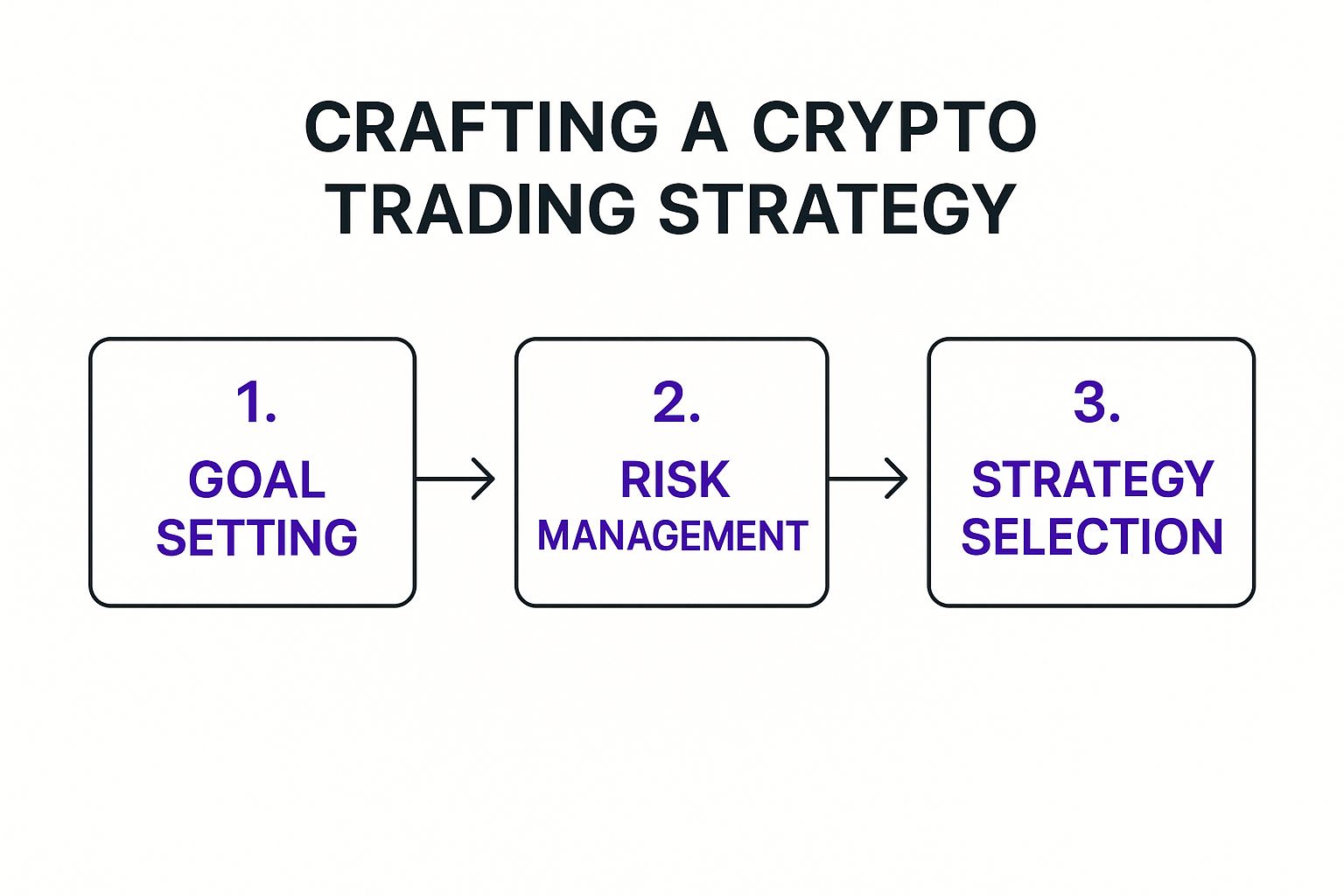
This process shows that successful trading isn't just about picking winners; it starts with clear goals and solid risk management before you even think about a specific strategy. By completing your first transaction, you’ve taken the most important step on that path.
Building A Smart Trading Strategy
Consistent success in crypto trading isn't about luck—it’s the direct result of having a solid strategy. This is where you shift from guessing to trading with intelligence. It all starts with the core principles that separate seasoned pros from emotional rookies.
The most important rule is also the simplest: never invest more than you are truly prepared to lose. This isn't just a catchy phrase; it's the foundation of sustainable trading. Before placing another trade, look at your capital and decide on an amount that, if it disappeared tomorrow, wouldn't throw your life off track. That’s your risk capital.
Understanding market volatility is crucial here. Look at what happened in the first quarter of 2025—the total crypto market cap dropped a staggering 18.6%. Even though Bitcoin's own value fell by 11.8%, its market dominance actually rose to 59.1%, a high not seen since early 2021. These numbers from the full Q1 2025 crypto industry report on CoinGecko show just how wildly things can swing, which is exactly why new traders need to be ready for anything.
Implementing Essential Risk Management Tools
Once you’ve got that core rule of risk down, your next move is to use tools that enforce it automatically. This is how you protect your capital from gut-wrenching losses in a market that can turn on a dime. As you start putting together a smart strategy, it's vital to get a handle on mastering risk management in trading to keep your investments safe.
Your best friend in this fight is the stop-loss order. Think of it as your safety net. It's an instruction you give vTrader to automatically sell your crypto if its price drops to a specific level. For instance, if you buy Bitcoin at $70,000, you could place a stop-loss at $68,000. If the price suddenly nosedives, your order gets triggered, selling your position and preventing a much bigger disaster.
Real-World Scenario: Picture two traders, Alex and Ben. Both buy an altcoin at $5. Alex, the strategist, immediately sets a stop-loss at $4.50 (a 10% loss). Ben, trading on pure hope, doesn't. When the coin unexpectedly tanks to $3, Ben is down 40% and freaking out. Alex is already out of the trade with a small, manageable loss, free to hunt for the next opportunity. Discipline is everything.
The Power of Diversification and a Trading Plan
You’ve heard it a million times: "don't put all your eggs in one basket." In crypto, this means diversifying your portfolio. Holding a mix of assets—like Bitcoin, Ethereum, and maybe a few promising altcoins—can soften the blow if one of them takes a nosedive. A diversified portfolio is almost always more stable than one riding on a single, high-risk bet.
But diversification alone isn't a magic bullet. You need a simple, written trading plan. It doesn’t have to be some 50-page document; it just needs to clearly outline your rules of engagement.
Here's what your trading plan should cover:
- Your Goals: What are you actually trying to do? Achieve modest monthly growth? Just learn the ropes? Be realistic.
- Entry Rules: What specific conditions need to be met before you even think about buying an asset?
- Exit Rules: When will you take profits? At what point will you cut your losses (your stop-loss strategy)?
- Position Sizing: How much of your capital will you risk on any single trade? Many experienced traders stick to risking just 1-2% of their total portfolio per trade.
A plan transforms you from a reactive gambler into a proactive strategist. When the market inevitably gets choppy, you’ll consult your plan instead of your emotions.
For those with a longer-term view, you can also make your assets work for you while they sit in your portfolio. Beyond active trading, platforms like vTrader offer other powerful opportunities. You might want to learn more about earning rewards through staking, which is a fantastic way to generate passive income from your holdings. It’s one more tool for building a truly well-rounded crypto strategy.
Common Questions For New Crypto Traders
Every new crypto trader has questions. It's just part of the game. Getting comfortable with digital assets is a journey, and curiosity is your best guide. Let's tackle some of the most common questions I hear from people just starting out, so you can trade with a bit more confidence.
How Much Money Do I Need To Start Trading Crypto?
This is the big one, and the answer usually surprises people: not much at all. On platforms like vTrader, you can get in the game with as little as $10 or $20. Honestly, the exact dollar amount isn't what's important here.
Here's the real golden rule: only put in what you are genuinely okay with losing. This is non-negotiable, especially when you're brand new. Think of your first few trades as your market "tuition"—you're paying to learn, not to get rich overnight. The goal is to understand the mechanics: placing an order, checking your balance, and tracking your history. Starting small takes the fear out of it and lets you focus on the process.
What Is The Difference Between Trading and Investing?
You'll hear these terms thrown around interchangeably, but in the crypto world, they represent two completely different mindsets. Picking the right one for you is crucial for hitting your financial goals.
- Trading is all about the short term. A trader is looking to profit from daily, hourly, or even minute-by-minute price swings. This is an active strategy that demands constant attention and a solid grasp of market analysis.
- Investing is the long game. An investor buys and holds an asset—what the crypto community calls "HODLing"—because they believe its value will grow significantly over months or years.
My advice for beginners? Start with an investor's mindset. Buy a small amount and just hold it. It’s the best way to get a feel for the market's volatility without the stress of trying to time every move perfectly.
Key Insight: Most newcomers find their footing by starting as investors. It lets you learn the rhythm of the market and see how prices move over time. Once you're comfortable with the swings, you can always explore more active trading strategies if they interest you.
How Are My Crypto Earnings Taxed?
Yes, taxes are a part of crypto. There’s no getting around it. In most places, including the United States, tax agencies treat crypto as property, not as currency. This single distinction has massive implications.
It means you're looking at a potential capital gains tax whenever you make a profit. A "taxable event" can be triggered when you:
- Sell your crypto back into cash.
- Swap one cryptocurrency for another (like trading Bitcoin for Ethereum).
- Use crypto to buy something, like a coffee or a laptop.
Tax laws are a minefield and they change constantly from one country to the next. It is absolutely vital that you talk to a qualified tax professional in your area who knows the crypto space. Trying to figure this out on your own is a recipe for very expensive mistakes.
For more answers, you can always check out the extensive FAQ section on vTrader, which covers everything from account details to security protocols.
Ready to put this knowledge to work? vTrader gives you a commission-free platform with the tools you need to start your crypto journey the right way. Sign up today and get a $10 bonus to kickstart your portfolio!

Steve Gregory is a lawyer in the United States who specializes in licensing for cryptocurrency companies and products. Steve began his career as an attorney in 2015 but made the switch to working in cryptocurrency full time shortly after joining the original team at Gemini Trust Company, an early cryptocurrency exchange based in New York City. Steve then joined CEX.io and was able to launch their regulated US-based cryptocurrency. Steve then went on to become the CEO at currency.com when he ran for four years and was able to lead currency.com to being fully acquired in 2025.
